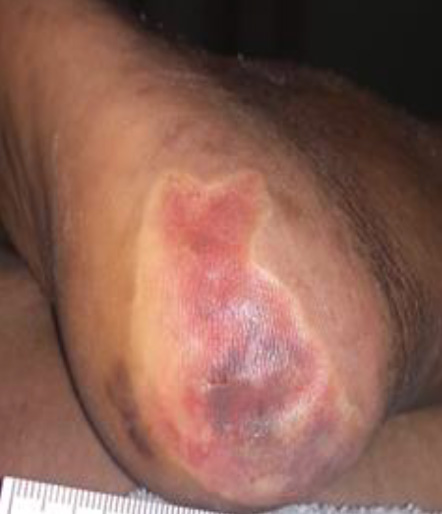What is a Deep Tissue Ulcer (DTI)?
When unrelieved pressure causes damage to the skin and underlying structures, an ulceration can develop, known as a pressure ulcer. There are many factors that can contribute to the development of a pressure injury such as friction, shear, moisture, pressure, limited mobility, obesity, or other comorbidities. A DTI is damage to deeper underlying structures overlaid with either intact or non-intact skin, occurring due to prolonged pressure at the bone-muscle interface. The indication that the damage is deep (versus superficial) is the non-blanchable deep red, maroon, or purple discoloration—in contrast to a superficial red Stage | ulcer.
How do you identify it?
Pressure injuries tend to occur over bony prominences on the body such as the shoulders, elbows, hips, sacrum, buttocks, ankles, heels and toes. DTI pressure injuries look like a deep bruise. If the outermost layer is not intact, then the epidermal separation will reveal a dark wound bed. It may also present as a blood- filled blister. Be careful not to confuse a DTI with a traumatic wound like a bruise or various dermatologic conditions that may present in similar fashion.
How do you treat it?
Treatment of DTI pressure ulcers is the same as all pressure ulcers—relieve pressure and prevent deterioration. Pressure relieving techniques such as positioning utilized in Stage | and II ulcers can be used. Applying skin prep will help to strengthen and protect the epidermal layer while the wound attempts to heal itself from underneath.
: 222 N. Pacific Coast Hwy. Suite 2175 = Materials Sourced from: El Segundo, CA 90245 Marriott, R., Gedalia, U., Dhillon, G., Sandoz, C., & Advantage _ 1e877.878.3289 Frazier, T. (2015). Wound Care Essentials. ASWC. SURGICAL & WOUND CARE info@advantagewoundcare.org Wound Educators. (n.d.).
 Upcoming Courses Learn More & Register Here
Upcoming Courses Learn More & Register Here
